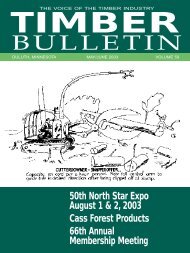Timber Bulletin Nov/Dec - Minnesota Forest Industries
Timber Bulletin Nov/Dec - Minnesota Forest Industries
Timber Bulletin Nov/Dec - Minnesota Forest Industries
You also want an ePaper? Increase the reach of your titles
YUMPU automatically turns print PDFs into web optimized ePapers that Google loves.
harvest – primarily the<br />
collaborative efforts of forestry<br />
professionals and an interested<br />
public. However, logging touches<br />
people at economic and emotional<br />
levels that motivate both<br />
controversey and the will to resolve<br />
it. Population issues are murkier,<br />
less easily defined.<br />
For the foreseeable future we are<br />
most likely to address forest<br />
problems in a piecemeal fashion, as<br />
we are presently doing with offroad<br />
vehicles. To go deeper<br />
requires value judgements most<br />
folks are unwilling to make. It is<br />
one thing to blame a logger you<br />
don’t know for cutting down trees,<br />
but quite another to admit the<br />
second home you just built<br />
diminishes the qualities of the<br />
forest you profess to desire.<br />
Perhaps the continued march of<br />
civilization deeper into the<br />
northwoods is an inevitable<br />
expression of Manifest Destiny in<br />
the 21st Century. We are not out of<br />
the woods yet when it comes to<br />
creating a vision for the<br />
conservation of <strong>Minnesota</strong>’s<br />
northern forests. Perhaps we never<br />
will be.<br />
Reprinted with permission from<br />
Outdoor News.<br />
Wet Cell Batteries<br />
Every year common, ordinary<br />
automotive batteries are<br />
responsible for minor mishaps such<br />
as peeling paint and electrical<br />
shocks. They are also to blame for<br />
more serious problems like severe<br />
eye injuries, acid burns, and<br />
catastrophic fires. Battery accidents<br />
happen because so many people<br />
handle batteries in a casual manner.<br />
Wet-call batteries are everywhere<br />
– in vehicles and other equipment<br />
or just sitting on the floor on the<br />
way to recycling. You can’t walk<br />
through many shops without<br />
literally tripping over them. Yet,<br />
they are very dangerous and<br />
demand your respect. It would be<br />
difficult to find a technician who<br />
hasn’t seen a battery explode. The<br />
purpose of this bulletin is to<br />
remind you of these dangers and<br />
provide information on how to<br />
protect yourself.<br />
Batteries hooked up to chargers<br />
present the greatest hazard for one<br />
reason: they produce explosive<br />
hydrogen gas. Extreme caution<br />
must be used when charging wetcell<br />
batteries of any size. Many<br />
people have found out the hard<br />
way that this gas can be easily<br />
ignited, and then start a<br />
catastrophic fire.<br />
Here’s how to protect yourself<br />
and employees:<br />
• Provide adequate ventilation in<br />
charging areas for disposal of<br />
hydrogen gas fumes from gassing<br />
batteries. Never charge batteries<br />
in a small, tightly sealed room!<br />
• Eliminate all ignition sources<br />
from the charging area. The<br />
hydrogen gas can’t explode<br />
without an ignition source, so<br />
remove or eliminate as many as<br />
possible. Keep the charging area<br />
clear of all combustible materials<br />
such as cardboard, wood, paper,<br />
etc.<br />
• Follow the manufacturer’s<br />
recommended procedures for<br />
using battery chargers. Everyone<br />
working in the battery-charging<br />
area should be aware of the<br />
hazards involved and properly<br />
trained in the correct procedure<br />
for charging batteries. Ensure that<br />
all cells are filled to the<br />
recommended level (if not<br />
maintenance free) with water and<br />
that all battery caps are in place<br />
prior to charging. Attach clips<br />
securely to batteries before<br />
turning the charger on to reduce<br />
that chance of a spark. Do not<br />
overcharge batteries; avoid<br />
overnight or extended charging<br />
times.<br />
• Employ good electrical practices.<br />
Plug battery chargers directly<br />
into grounded electrical outlets;<br />
avoid using extension cords that<br />
can overheat. Don’t alter or<br />
modify the charger itself, the<br />
power cord or clips.<br />
• Fire and explosion are not the<br />
only hazards associated with<br />
batteries. They also contain very<br />
dangerous sulfuric acid that can<br />
burn, maim and blind anyone.<br />
Technicians work around<br />
batteries constantly. They tend to<br />
forget how dangerous batteries<br />
are and treat them in a careless<br />
manner. Remind everyone of the<br />
dangers of handling wet-cell<br />
batteries and follow these<br />
common-sense precautions:<br />
• Wear proper PPE (Personal<br />
Protective Equipment) when<br />
handling, and most importantly,<br />
whenever working around<br />
charging batteries. Proper eye<br />
protection is most important. Eye<br />
protection means more than<br />
ordinary safety glasses. Goggles<br />
worn in conjunction with fullface<br />
shields provide the best<br />
protection. Acid-resistant gloves<br />
and aprons should also be worn.<br />
• Provide an emergency eyewash.<br />
The eyewash must meet OSHA<br />
standards by being readily<br />
accessible and provide a 15-<br />
minute “flushing” supply of<br />
water.<br />
• Use extreme caution when jumpstarting<br />
or charging vehicle<br />
batteries. A battery being charged<br />
while it is still in a vehicle is<br />
more dangerous than one<br />
charged elsewhere. You should<br />
stand clear of the battery during<br />
charging operations. You should<br />
also remove all jewelry before<br />
working around batteries.<br />
Remember to keep tools and<br />
other metallic objects away from<br />
the top of uncovered batteries,<br />
and remove all ignition sources<br />
from the area. Attach the charger<br />
to the battery prior to turning it<br />
on. Ensure that the clips are<br />
secured to the posts and have a<br />
strong electrical connection.<br />
• Neutralizing agents should be<br />
available for electrolyte spills.<br />
Bicarbonate soda, lime or other<br />
commercially available<br />
neutralizing chemicals should be<br />
kept on hand to treat acid or<br />
electrolyte spills. Store all<br />
batteries on wood pallets,<br />
preferably inside in a segregated<br />
area. Leaking or damaged<br />
batteries must be placed in an<br />
acid-resistant leak-proof<br />
container. Avoid storing used<br />
batteries outside because they<br />
may pollute the ground water.<br />
Keep the number of used<br />
batteries on hand to a minimum;<br />
have them removed in a timely<br />
manner.<br />
Using common sense when<br />
charging or handling batteries will<br />
help protect you from unnecessary<br />
loss. Train employees on safe<br />
procedures and then make sure<br />
they are followed. Your employees<br />
and your business depend on it.<br />
Reprinted with permission from the<br />
<strong>Timber</strong> Producers Association of<br />
Michigan and Wisconsin, Sept. 2002.<br />
28 <strong>Timber</strong> <strong>Bulletin</strong> <strong>Nov</strong>ember/<strong>Dec</strong>ember 2002

















